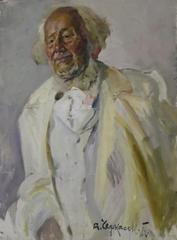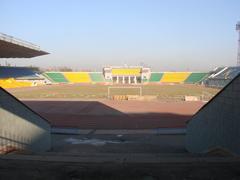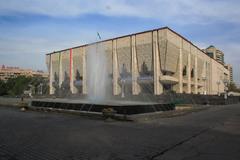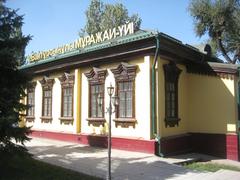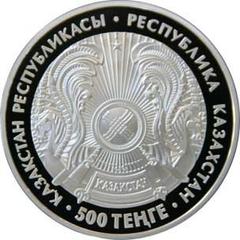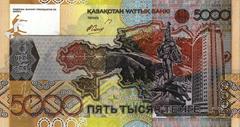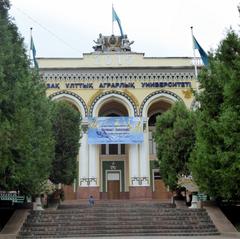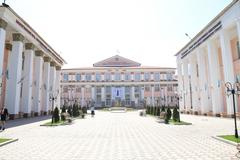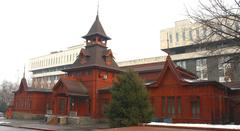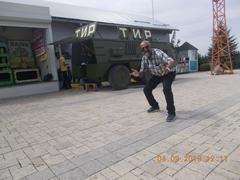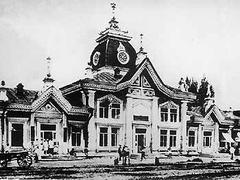House of Merchant Gabdulvaliev: Visiting Hours, Tickets, and Historical Significance in Almaty
Date: 04/07/2025
Introduction
The House of Merchant Gabdulvaliev—also known as the Kyzyl-Tan Trading House—stands as an enduring testament to Almaty’s mercantile roots and architectural heritage. Situated on Jibek Joly Street in the heart of Kazakhstan’s largest city, this late 19th-century monument blends Russian neoclassical, Central Asian, and local design elements, reflecting Almaty’s evolution from a Silk Road outpost into a cosmopolitan urban center. As a state-protected site, it offers a unique window into the city’s multicultural history, entrepreneurial spirit, and urban transformation. This comprehensive guide details everything you need to plan your visit: from opening hours and ticketing, to architectural highlights, accessibility, and nearby attractions.
For further insights, see resources such as the Almaty Historical Reserve, Wikiwand’s article on Kyzyl-Tan, and Astana Times on Almaty’s heritage.
Table of Contents
- Introduction
- Historical Background
- Architectural Significance
- Visiting Information
- Nearby Attractions
- Practical Tips for Visitors
- Frequently Asked Questions (FAQ)
- Visuals and Media
- References and Further Reading
- Conclusion
Historical Background
Origins and Construction
Commissioned in the late 19th or early 20th century by Iskhak Gabdulvaliev, a prominent Tatar merchant, the house originally served as a trading post for textiles and fabrics. Sources differ on the exact year and architect—some attribute its design to Paul Gourdet (c. 1896), while others suggest Andrey Zenkov (1912)—but all agree on its importance in Almaty’s (then Verny) commercial history. The building’s construction coincided with a period of rapid economic growth, fueled by the city’s strategic position along the Silk Road and its thriving multi-ethnic merchant community (Wikiwand: Kyzyl-Tan (Almaty)).
Evolution Through History
Following Gabdulvaliev’s death, the property remained in family hands until nationalized after the 1917 Russian Revolution. It later housed the Soviet “Torgsin” store and, by the 1980s, became a specialty fabric store. Throughout its varied uses, the building retained its social function, serving as a hub for local trade and community gatherings (Astana Times: Almaty, a Journey Through Time and Names).
Preservation and Recognition
Designated a cultural monument by the Alma-Ata City Council in 1979 and granted national importance status in 1982, the house underwent significant restoration to preserve its unique architectural character. Since 2008, it has been managed by House of Fabrics Kyzyl-Tan LLP, maintaining its connection to the textile trade (Wikiwand: Kyzyl-Tan (Almaty)).
Architectural Significance
Style and Features
The House of Merchant Gabdulvaliev is a striking example of the “new-Russian” architectural style, characterized by:
- Ornate Wooden Cornices and Carvings: Decorative elements reflecting Russian and Central Asian motifs.
- Symmetrical Facade with Dome and Spire: A distinctive roofline that anchors the building within the streetscape.
- Timber Construction: Built from resilient Tian Shan spruce, employing techniques designed to withstand seismic activity (eurasia.travel).
- Neoclassical Details: Columns, pilasters, and geometric trims add an air of European elegance.
Interior Layout
The interior preserves much of its original plan:
- Ground Floor: Reception rooms, offices, and trading areas.
- Upper Floors: Private family quarters.
- Restored Spaces: Some rooms feature period-appropriate furnishings, while others are adapted for exhibitions and educational use.
Cultural Symbolism
The house’s architecture mirrors Almaty’s multicultural past, blending Tatar, Russian, and Kazakh influences. Its resilience through earthquakes and urban development stands as a metaphor for the city itself (Astana Times: Almaty, a Journey Through Time and Names).
Visiting Information
Location and Getting There
- Address: 63 Jibek Joly Street, Almaty
- Access: Easily reached by public transport (Zhibek Zholy metro station), taxi, or on foot from the city center (Travelspilot).
- Nearby Landmarks: Panfilov Park, Green Bazaar, Zenkov Cathedral, Arbat Street (Zhibek Joly).
Opening Hours and Tickets
- Hours: Tuesday–Sunday, 10:00 AM–6:00 PM. Closed Mondays and on public holidays.
- Tickets: Adults: 500–1,000 KZT; students, seniors, and children: discounted/free. Purchase on-site or via the museum’s website when available.
- Guided Tours: Available in Kazakh, Russian, and occasionally English. Advance booking recommended, especially for English tours or group visits.
Accessibility
- Wheelchair Access: Main entrance is accessible; portable ramps available. Some upper floors may be inaccessible due to historic structure.
- Facilities: Restrooms and a small gift shop are on-site.
Nearby Attractions
- Ascension Cathedral: An iconic wooden Orthodox church, renowned for its earthquake-resistant design.
- Green Bazaar: A bustling market offering local produce, crafts, and traditional foods.
- Panfilov Park: A tranquil green space commemorating WWII heroes.
- Arbat Street (Zhibek Joly): A lively pedestrian avenue filled with shops, cafes, and local art (RootsAbroadTravel).
Practical Tips for Visitors
- Best Time to Visit: April–October for mild weather and vibrant city life (TimeTravella).
- What to Wear: Comfortable clothing and sturdy shoes are advisable.
- Language: Kazakh and Russian are most common; English guides may be arranged in advance.
- Photography: Allowed inside and outside; flash and tripods may be restricted.
- Safety: Almaty is generally safe. Standard precautions apply; the museum area is well-trafficked.
Frequently Asked Questions (FAQ)
Q: What are the House of Merchant Gabdulvaliev’s visiting hours?
A: Tuesday–Sunday, 10:00 AM–6:00 PM; closed on Mondays.
Q: How can I buy tickets?
A: On-site or, when available, through the museum’s official website. Advance booking is recommended for tours.
Q: Is the house accessible for visitors with disabilities?
A: Partial accessibility; main entrance is ramped, but some upper floors may not be reachable.
Q: Are guided tours available in English?
A: Yes, but book in advance to ensure availability.
Q: Can I take photographs inside?
A: Yes, though flash and tripods may be restricted. Professional shoots require permission.
Visuals and Media
Alt text: Exterior view of the House of Merchant Gabdulvaliev, a historic architectural monument in Almaty.
Alt text: Map highlighting the location of the House of Merchant Gabdulvaliev on Jibek Joly Street in Almaty.
For digital resources, virtual tours, and more, consult the museum’s website and trusted travel blogs.
References and Further Reading
- Almaty Historical Reserve (eurasia.travel)
- Kyzyl-Tan (Almaty) (Wikiwand)
- Almaty, a Journey Through Time and Names (Astana Times)
- Almaty Itinerary and Travel Guide (Travelspilot)
- Almaty’s Cultural and Tourism Gem (CGTN)
- RootsAbroadTravel: Things to Do in Almaty, Kazakhstan
- TimeTravella: Almaty Guide
- IndiTourists: Visiting Almaty
- MyWanderlust: Things to Do in Almaty
- Adventure Backpack: Almaty Culture
Conclusion
The House of Merchant Gabdulvaliev is more than an architectural marvel—it is a living chronicle of Almaty’s mercantile legacy, multicultural identity, and resilience. Whether you’re a history enthusiast, architecture buff, or casual traveler, a visit here immerses you in the stories and artistry that shaped Kazakhstan’s largest city. Enhance your experience by exploring neighboring attractions, joining a guided tour, and using digital resources like the Audiala app for seamless travel planning. Step into this iconic monument and discover the enduring legacy of Almaty’s merchant class.
Plan your visit today and be part of Almaty’s living history!
